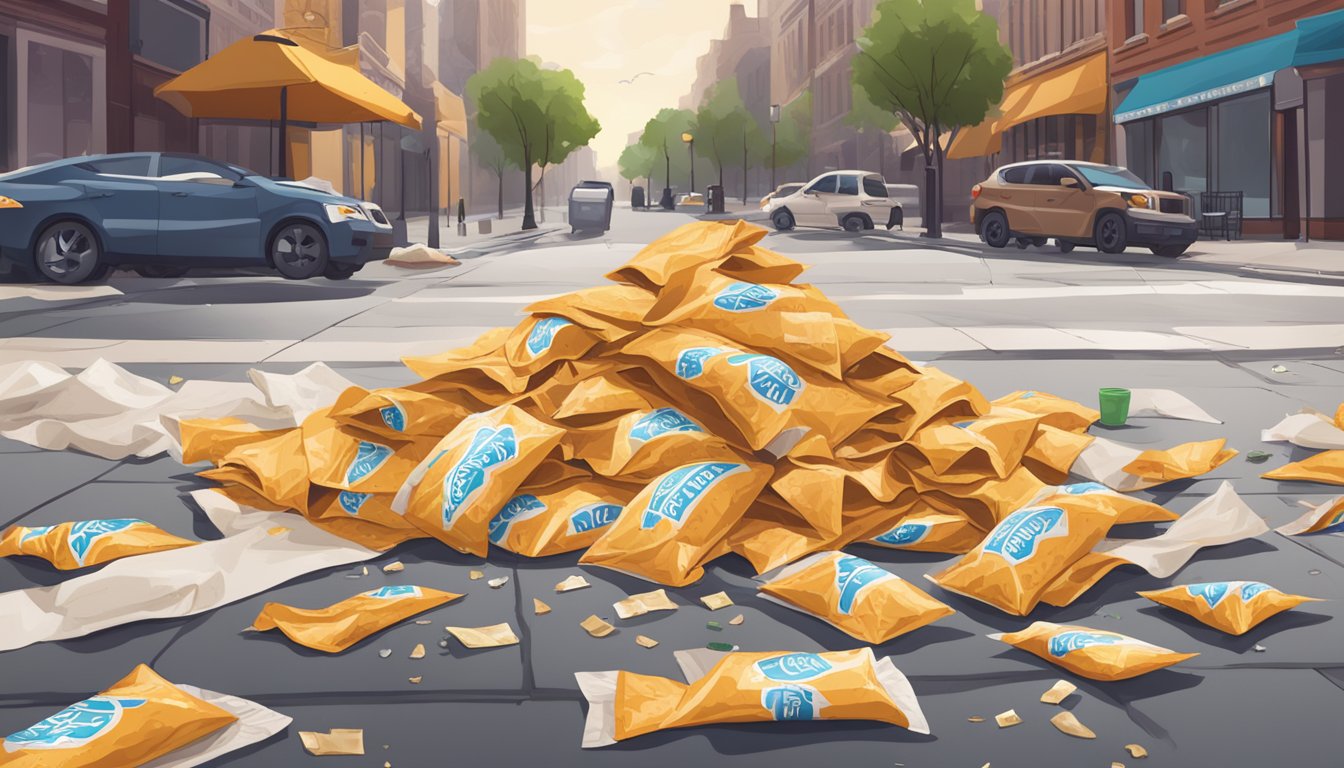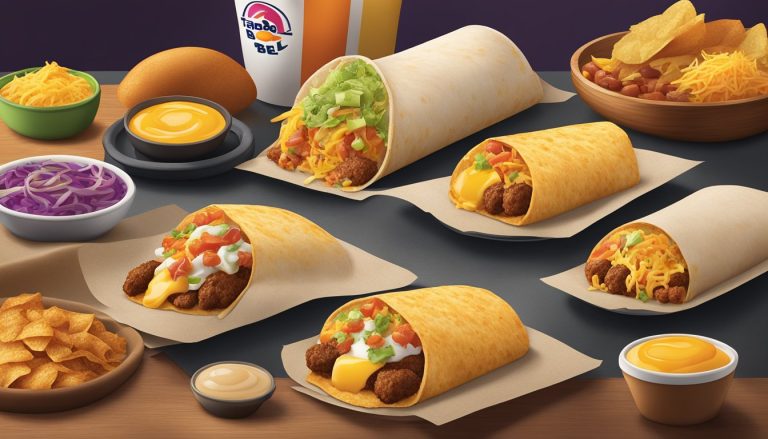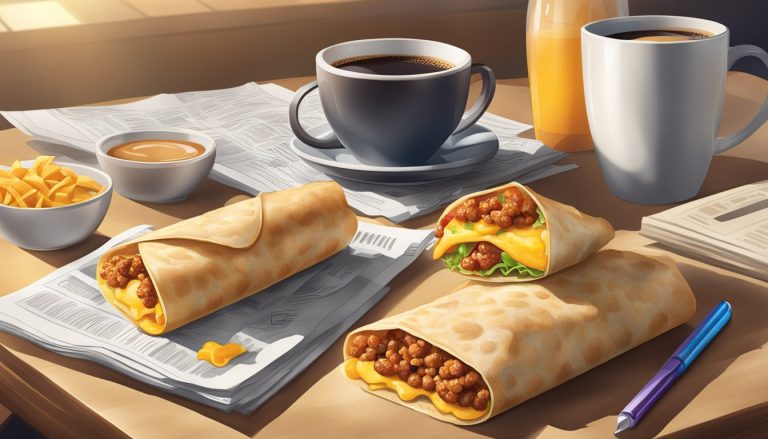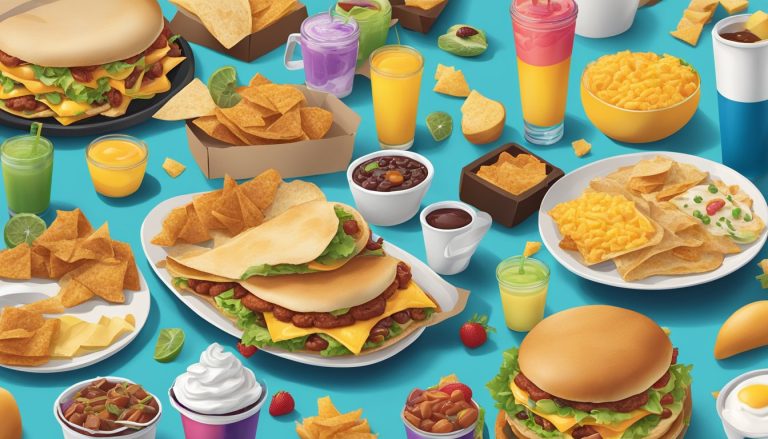Taco Bell’s breakfast packaging has become a focal point in discussions about fast food’s environmental impact. As more consumers prioritize sustainability, the chain has taken steps to address concerns about waste and pollution from its packaging materials.
Taco Bell aims to make all consumer-facing packaging recyclable, compostable, or reusable worldwide by 2025. This ambitious goal reflects a growing trend in the food industry to reduce environmental footprints and respond to customer demands for more eco-friendly practices.
The company’s efforts extend beyond just breakfast items, encompassing its entire menu and global operations. Taco Bell has already made progress by using paper bags made from 100% recyclable and renewable sources in the United States. These initiatives demonstrate the potential for large-scale fast food chains to make meaningful changes in their environmental practices.
Taco Bell’s Commitment to Sustainability

Taco Bell has set ambitious environmental goals and is partnering with suppliers and franchisees to reduce its ecological footprint. The fast-food chain is taking concrete steps to make its packaging more sustainable and promote responsible farming practices.
2025 Environmental Goals
Taco Bell aims to make all consumer-facing packaging recyclable, compostable, or reusable by 2025 globally. This initiative builds on existing efforts, as the company has already introduced fully recyclable cold cups and lids.
To support this goal, Taco Bell plans to install recycling and/or compost bins at locations where infrastructure allows. The company is also working to phase out toxic chemicals in its food packaging, demonstrating a commitment to both environmental and consumer health.
Collaboration With Suppliers and Franchisees
Taco Bell is extending its sustainability efforts beyond its own operations. The company is collaborating with food supplier Cargill and the National Fish and Wildlife Foundation to promote regenerative cattle farming practices and habitat preservation.
This partnership aims to address the environmental impact of Taco Bell’s beef supply chain, which amounts to 290 million pounds annually. By working with suppliers, Taco Bell seeks to reduce its carbon footprint and support more sustainable agricultural methods.
The fast-food giant is also engaging franchisees in its sustainability initiatives. This collaboration ensures that environmental goals are implemented consistently across Taco Bell locations, maximizing the impact of the company’s sustainability efforts.
Environmental Concerns With Breakfast Packaging

Taco Bell’s breakfast packaging raises several environmental issues related to materials and chemical composition. These concerns stem from the types of materials used and the presence of potentially harmful compounds.
Analysis of Materials Used
Taco Bell’s breakfast packaging utilizes various materials, including paper, plastic, and aluminum. Paper products like bags and wrappers are often made from virgin wood pulp, contributing to deforestation. Plastic containers and lids are typically derived from fossil fuels, a non-renewable resource. Aluminum foil, while recyclable, requires significant energy to produce.
Some packaging components may incorporate mixed materials, complicating recycling efforts. For example, paper cups with plastic lining cannot be easily separated for recycling. This leads to increased waste in landfills or incineration facilities.
Presence of Non-Recyclable Compounds
Taco Bell’s breakfast packaging may contain chemicals of concern like PFAS, BPA, and phthalates. PFAS (per- and polyfluoroalkyl substances) are often used for grease-resistance in food packaging. These persistent chemicals can leach into food and the environment, posing potential health risks.
BPA (bisphenol A) is commonly found in plastic containers and can disrupt endocrine function. Phthalates, used to soften plastics, have been linked to developmental issues. These compounds make recycling difficult and can contaminate recycling streams.
Taco Bell has committed to phasing out these chemicals by 2025. This move aims to improve packaging sustainability and reduce environmental impact. However, finding suitable alternatives that maintain food safety and quality remains a challenge.
Recycling and Composting Initiatives

Taco Bell is taking significant steps to reduce the environmental impact of its breakfast packaging. The company aims to make all consumer-facing packaging recyclable, compostable, or reusable by 2025.
Recyclable Breakfast Packaging Options
Taco Bell is consolidating and eliminating unnecessary packaging elements to streamline its breakfast offerings. The company is exploring innovative materials that can be easily recycled while maintaining food quality and safety. New recyclable packaging options include:
• Paper-based wraps for breakfast burritos
• Compostable fiber bowls for breakfast bowls
• Recyclable plastic lids for coffee cups
These alternatives help reduce waste and promote circular economy principles. Taco Bell is also working with suppliers to develop packaging made from recycled content, further reducing its environmental footprint.
Composting Bins and Consumer Participation
To support its sustainability goals, Taco Bell is installing recycling and composting bins in restaurants where local infrastructure allows. This initiative encourages customers to properly dispose of their breakfast packaging. Key aspects include:
• Clear signage to guide proper waste sorting
• Employee training on composting and recycling processes
• Partnerships with local waste management companies
Taco Bell is also educating consumers about the importance of participating in recycling and composting efforts. The company uses in-store displays and social media campaigns to raise awareness about sustainable disposal practices.
Reducing Single-Use Items and Encouraging Reuse

Taco Bell is taking steps to minimize its environmental footprint by addressing single-use packaging and promoting reusable alternatives. These efforts aim to reduce waste and conserve resources across its breakfast menu offerings.
Alternative to Traditional Packaging
Taco Bell has introduced several eco-friendly options for its breakfast items. The mini skillet bowl now comes in recyclable cold cups, eliminating disposable plastic containers. Food baskets made from recycled materials have replaced single-use paper trays for certain menu items.
Paper straws have been substituted for plastic ones, significantly reducing plastic waste. The company encourages customers to skip straws altogether when possible. Taco Bell has also implemented a reusable bag program, offering durable bags for purchase that can be used repeatedly for takeout orders.
To further promote reuse, Taco Bell is testing a deposit system for reusable containers at select locations. Customers pay a small fee for a sturdy, washable container and receive a refund upon return. This initiative aims to cut down on disposable packaging waste while maintaining food safety standards.
Taco Bell’s Vegetarian and Vegan Offerings

Taco Bell has expanded its menu to cater to vegetarian and vegan customers. The fast-food chain offers a variety of plant-based options that are both tasty and environmentally conscious.
Environmentally Friendly Menu Options
Taco Bell’s vegetarian menu is certified by the American Vegetarian Association. This certification ensures that vegetarian items meet strict criteria. The chain’s black beans and seasoned rice serve as protein-rich, meat-free alternatives.
Customers can easily customize most menu items to be vegetarian or vegan. Substituting beans for meat and removing dairy products like cheese and sour cream creates vegan-friendly meals. Taco Bell’s website and app allow for easy customization of orders.
The restaurant offers over 1,000 vegetarian combinations during breakfast hours alone. However, vegan breakfast options are limited, with only hash browns currently available. Taco Bell has tested vegan nacho cheese made from chickpeas and soy, showing potential for future plant-based additions.
Popular vegetarian items include the Bean Burrito and Cheesy Bean and Rice Burrito. For vegans, the Crunchwrap Supreme can be modified by replacing beef with black beans and removing cheese and sour cream.
Impact of Taco Bell’s Breakfast Packaging on Waste Management

Taco Bell’s breakfast packaging contributes significantly to waste streams and landfills. The volume of single-use containers and wrappers from morning meals adds to environmental challenges.
Contribution to Landfills and Waste Streams
Taco Bell serves millions of breakfast items daily, generating substantial packaging waste. Single-use containers, wrappers, and utensils often end up in landfills due to improper disposal or lack of recycling options.
The company’s breakfast offerings, including burritos, tacos, and hash browns, typically come in paper or plastic packaging. These materials can take years to decompose in landfills, occupying valuable space and potentially releasing harmful chemicals.
Non-recyclable or contaminated food packaging further exacerbates the problem. Greasy wrappers and sauce-stained containers are often unsuitable for recycling, increasing the waste sent to landfills.
To address these issues, Taco Bell has set a goal to make all consumer-facing packaging recyclable, compostable, or reusable by 2025. This initiative aims to reduce the environmental impact of their breakfast packaging and overall waste management challenges.
Customer Experience and Packaging
Taco Bell’s breakfast packaging directly impacts customer satisfaction and operational efficiency. The design and materials used affect both drive-through speed and the dining experience.
Drive-Through and Dining Experience
Taco Bell’s breakfast packaging plays a crucial role in the quick-service restaurant’s drive-through operations. Sturdy containers prevent spills and keep food hot, ensuring customer satisfaction even when meals are consumed on-the-go.
The packaging’s ease of use is essential for drive-through efficiency. Containers that stack well and fit securely in cup holders allow for faster order assembly and handoff times.
In-restaurant diners benefit from packaging that’s easy to open and eat from. Trays and wrappers that double as placemats provide convenience and reduce mess. Clear labeling on packages helps customers identify their orders quickly.
Taco Bell’s transition to more sustainable packaging may introduce new textures and appearances. This change could influence customer perceptions of food quality and freshness, potentially affecting their overall dining experience.
Assessing the Carbon Footprint

Taco Bell’s breakfast packaging contributes significantly to the company’s overall environmental impact. The carbon footprint of these materials spans their entire lifecycle, from production to disposal.
Life Cycle of Taco Bell’s Breakfast Packaging
The carbon footprint of Taco Bell’s breakfast packaging begins with raw material extraction. Manufacturing processes for paper, plastic, and other packaging components generate greenhouse gas emissions. Transportation of materials and finished packaging to Taco Bell locations adds to the carbon impact.
In-store use of packaging has a relatively small carbon footprint. However, disposal methods greatly affect the overall environmental impact. Landfilled packaging contributes to methane emissions, while recycling or composting can reduce the carbon footprint.
Taco Bell has made efforts to improve packaging sustainability. The company partnered with Berry Global Group to introduce cups containing recycled plastic. This initiative aims to reduce virgin plastic use and associated carbon emissions.
Comprehensive life cycle assessments help quantify the carbon footprint of packaging choices. These analyses consider factors like material sourcing, production energy, transportation, and end-of-life scenarios. Such assessments guide Taco Bell in making more environmentally conscious packaging decisions.




